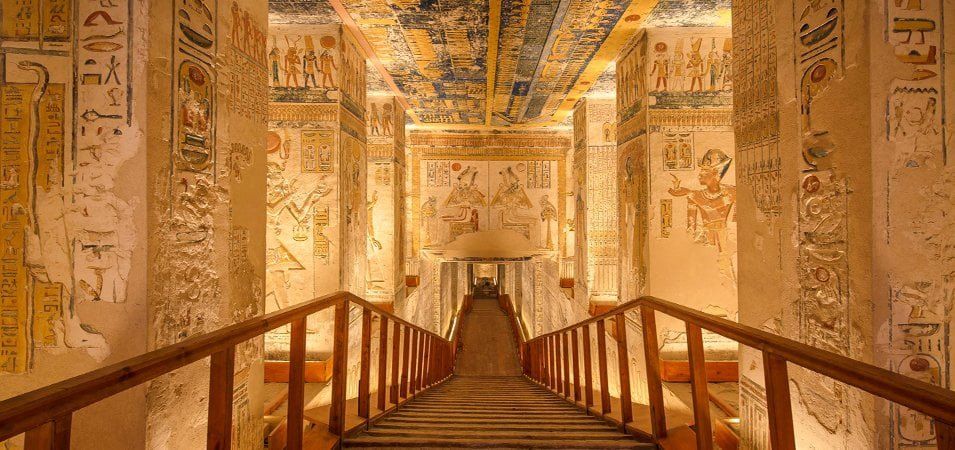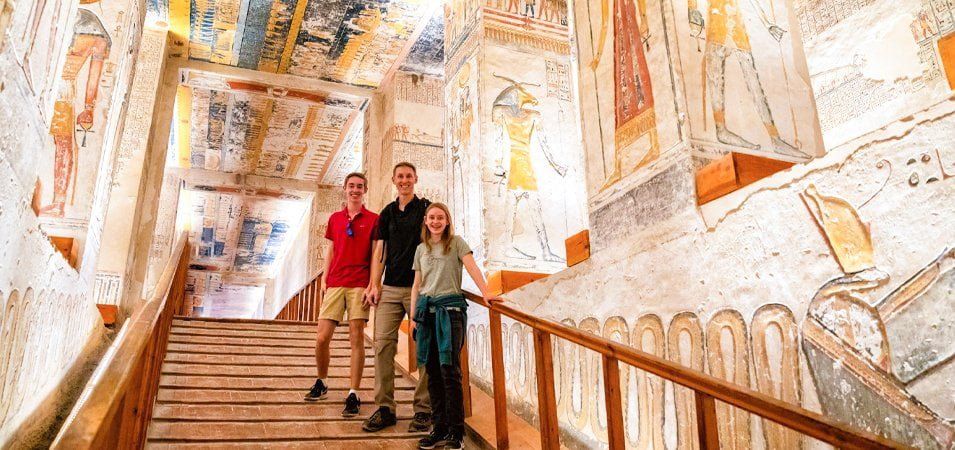The Valley of the Kings is right in the middle of Luxor. It is a place full of history and secrets ready to be found. This ancient burial ground is on the west bank of the Nile River. It is where many ancient Egyptian pharaohs from the New Kingdom time are buried. This old graveyard is the key to knowing how grand and complicated Egypt was during the New Kingdom. The Valley of the Kings continues to draw people worldwide because of its long past, beautiful architecture, and interesting artifacts. Let’s go on a trip through time as we try to figure out what’s happening in the Valley of the Kings.
Luxor Temple in Egypt: A Look Back at the Past’s Beauty
History of the Valley of the Kings

The exciting history of the Valley of the Kings in Luxor, Egypt, goes back to the time of the New Kingdom in ancient Egypt. During the New Kingdom, which lasted from about 1600 BC to 1100 BC, the Valley of the Kings was where pharaohs, lords, and other important people were buried. Pharaohs chose this quiet Valley to build their graves so that grave robbers couldn’t reach them. Because the Valley is in a good spot and has natural barriers, these sacred burial places have been safe for thousands of years. Over the years, the Valley became a cemetery where pharaohs, lords, and other important people were buried. The Valley of the Kings is a reminder of how important and grand the ancient Egyptian society was.
Architecture and Design
The tombs in the Valley of the Kings show how good the ancient Egyptians were at engineering and art by how they were built and designed. The tombs were carefully carved into the Valley’s rock faces. They had complicated tunnels and rooms that led to the burial chambers deep in the ground. On the walls of the tombs were colorful paintings and hieroglyphic writings that showed religious rituals, mythological scenes, and the pharaoh’s trip to the afterlife.
Tombs of the Pharaohs
Tutankhamun’s Tomb
When Howard Carter found it in 1922, Tutankhamun’s burial room became the most famous tomb in the Valley of the Kings. It captivated people all over the world. The tomb was full of treasures and objects, like the famous golden mask on the mummy of the young pharaoh.
Ramses II’s Tomb
Ramses II, one of Egypt’s most powerful pharaohs, chose the Valley of the Kings as where he would be buried forever. His tomb, called KV7, is a beautiful reminder of how he ruled and what he left behind. The tomb is in Luxor, Egypt, and is known for its grand and complicated nature. The walls of the tomb of Ramses II are covered with reliefs and hieroglyphs that show scenes from his life, wars, and religious ceremonies. Looking around the tomb, you can see the wealth and power of Ramses II’s rule. It also shows off the artistic skills and building skills of ancient Egypt.
Seti I’s Tomb
Seti I was an important pharaoh in ancient Egypt during the time of the New Kingdom. He picked the Valley of the Kings to be his final resting place. His tomb, which is called KV17, is a beautiful piece of architecture that shows the grandeur and skill of the time. Seti I’s tomb in Luxor, Egypt, is famous for how beautiful it is and how much detail it has. The tomb’s walls are covered with murals and reliefs that show scenes from mythology, religious rites, and the pharaoh’s life. Exploring Seti I’s tomb is a fascinating trip through old Egyptian history. It shows how vital the pharaoh was and keeps his name alive.
Tomb of Hatshepsut
One of the most famous tombs in the Valley of the Kings is the Tomb of Hatshepsut, also called KV20. Hatshepsut, an important pharaoh in ancient Egypt, wanted to be buried at this holy spot. The tomb is in Luxor, Egypt, showing how different architecture and design were during her rule. The rooms and hallways of the tomb have beautiful reliefs that show scenes from her life and the things she did as pharaoh. Exploring the Tomb of Hatshepsut shows us the fantastic things this powerful queen left behind. It also shows how ancient Egyptians used art and symbols in funeral rituals.

The Secrets of the Tombs
Many secrets are waiting to be found in the tombs in the Valley of the Kings. Each tomb shows what the pharaohs and nobles of ancient Egypt thought, how they lived, and what they did. Archaeologists and explorers have been drawn to the graves for centuries by their detailed wall paintings, hieroglyphic writing, and secret rooms. These secrets show how complicated Egyptian religion and death rituals were then. They also offer how the Egyptians thought about the afterlife and the pharaoh’s journey to forever. Exploring the tombs in the Valley of the Kings is a fascinating way to learn about a society that still has a lot of mysteries.
Hot Air Balloon in Luxor – An Enchanting Experience
Preservation Efforts of The Valley of The Kings
Protecting the fragile tombs and objects in the Valley of the Kings is imperative. Together with foreign organizations, the Egyptian government has put a lot of money and time into protecting and preserving this important archaeological site. Strict rules and regulations are in place to protect the tombs in the long run. Conservation teams use high-tech methods to support the buildings, stop them from falling apart, and stop the damage to the environment and people. Through ongoing repair projects and careful care, these preservation efforts aim to keep the Valley of the Kings’ priceless treasures safe so that people in the future can study and enjoy them.
Unearthing Treasures: Artifacts and Relics
The Valley of the Kings has given up a lot of treasures and artifacts that tell us a lot about the culture and ideas of ancient Egypt. Some items found in these sacred tombs include statues, masks, amulets, and papyrus scrolls made with great care. Because of these findings, We know a lot more about the religion, art, and social life of the New Kingdom.
Mysteries and Legends of The Valley of The Kings
There are many tales and stories about the Valley of the Kings. From stories about old curses to unsolved puzzles, the tombs have had a mysterious air that has drawn explorers and archaeologists for hundreds of years. Some people think some tombs haven’t been found yet, while others wonder what hidden rooms in known graves mean.
Modern-Day Tourism
Today, people from all over the world come to the Valley of the Kings to see the fantastic things that old Egypt had to offer. Guided tours allow you to look inside many open tombs and hear the fascinating stories behind them. Walking through the same hallways that pharaohs used to walk through is a fantastic experience that takes people back in time.
Exploring the Valley of the Kings
Exploring the Valley of the Kings in Luxor, Egypt, is a fantastic journey through old Egyptian history. As you step into this holy burial ground, you are taken back in time, surrounded by beautiful buildings and detailed artwork. Guided tours tell you about the exciting stories behind the tombs and let you see how great and rich the pharaohs were. Walking through the halls and rooms decorated with bright murals and hieroglyphic writing makes you feel amazed and respectful. In the Valley of the Kings, you can learn about a fantastic culture and discover the secrets of the pharaohs.
Valley of the Kings: A Timeless Legacy
The Valley of the Kings is a great example of how grand and smart the ancient Egyptians were. Its tombs, art, and archaeological finds continue to teach us about the lives and views of the pharaohs and those who lived under them. The Valley of the Kings has been important for a long time, and its history makes us want to learn more about a fantastic time.

Tutankhamun’s Tomb: A Fascinating Glimpse at its Treasures
Tips for Visitors of The Valley of the Kings
For visitors planning to explore the Valley of the Kings, here are some helpful tips:
- Wear shoes and clothes that are easy to walk and climb in because you’ll be doing much of that.
- Bring sunscreen, a hat, and lots of water so you don’t get too hot in the Egyptian sun.
- Follow the rules and directions your tour guide and site staff give you to keep yourself safe and protect the tombs.
- Consider hiring a knowledgeable guide to tell you more about the tombs’ history and importance.
- Show respect for the old things and don’t touch or damage them.
- If you can, take pictures to remember the place, but be aware of other people there.
- look at the beautiful artwork and learn about the site’s long past.
Conclusion
In conclusion, The Valley of the Kings in Luxor has a lot of historical and cultural importance. It is a great example of how unique old Egyptian culture was. Its exciting history, architecture and priceless artifacts amaze and teach tourists. Exploring this sacred burial ground reveals the customs, beliefs, and artistic achievements of a society that left an indelible mark on the history of the world. Plan your trip to the Valley of the Kings today and get ready for a journey through time that you will never forget.
